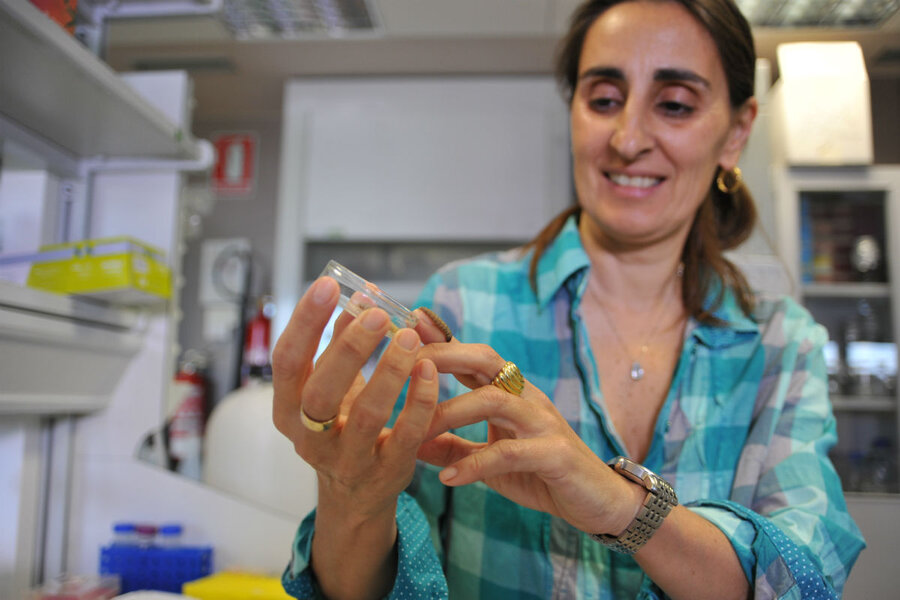Could this rather esurient caterpillar help stem the plastic deluge?
Loading...
Despite living just six or seven weeks, they may be able to take down an enemy that lingers for centuries.
The lowly caterpillar Galleria mellonella, also known as the wax worm, can digest a type of plastic commonly found in packaging, according to a paper published Monday in Current Biology. The finding continues a string of recently discovered plastic-eating organisms that has some scientists hoping nature might share some of its tricks and help us rid the environment of the alien materials.
The discovery was a true eureka moment. When scientist and amateur beekeeper Federica Bertocchini found pesky caterpillars crawling over her homegrown honeycombs, she plucked them off and imprisoned them in the membrane of a plastic bag.
But a short while later she returned to a shocking scene. The worms had made a jailbreak, leaving behind nothing but holes in a shopping bag that could have otherwise far outlived both her and the critters.
"There was only one explanation: the worms had made the holes and had escaped. This project began there and then," explained the Spanish National Research Council (CSIC) scientist in a press release.
A battery of tests confirmed Dr. Bertocchini’s assumption. The caterpillars were indeed digesting, not just tearing, the polyethylene, a batch of 100 gobbling up 92 milligrams of the stuff in half a day, “which really is very fast," according to Bertocchini.
Collectively we produce hundreds of millions of tons of plastic yearly, of which polyethylene makes up about 40 percent. Perhaps 8 million of those tons end up in the ocean, where they break down into omnipresent shards now making their way as far as the Arctic. What large-scale effects this environmental newcomer could have is completely unknown.
“We don’t know what the damages are of having pieces of plastic in the ocean. I think it’s an uninvited guest,” says Woods Hole Oceanographic Institution senior scientist and ocean pollution researcher Christopher Reddy, who was not involved in the research.
While plastics belong to the same class of large molecules as cotton, fingernails, and wood, their durability makes them tough targets for the little organisms who break down everything else. After all, no one wants a pen that rots.
“We’re designing chemicals and we’re designing products because of their stability. We’re a victim of our own success,” says Dr. Reddy in a phone interview.
But most plastics are made from carbon-rich fossil fuels, a potent source of energy, and one that the wax worm can handle. The adult moth lays eggs in beeswax, which features carbon-carbon bonds much like those found in polyethylene. Bertocchini’s team speculates that the pupae’s plastic-chomping superpower may spring from their ability to digest the wax as they develop.
With this discovery, the caterpillars join a roster of plastic-fighting organisms including last year’s Ideonella sakaiensis bacteria and 2011’s Amazonian fungus, bolstering hopes that nature will show us efficient ways to get rid of our waste.
“Given the fast rate of biodegradation reported here, these findings have potential for significant biotechnological applications,“ the team wrote in their paper.
But real hurdles stand between these iron-gutted organisms and a plastic-free planet, not the least of which is getting them to do our bidding and pick plastic over other, possibly tastier, foods.
“When it comes to microbial breakdown, it’s like asking teenagers to clean their rooms on the weekend,” explains Reddy. “They may do it, they may not do it. They may do a little. They may do the easiest way first.”
Nature tends to takes the path of least resistance, which might lead a handful of very hungry caterpillars to chew their way to freedom. However, scaling up that lab-bench behavior into a plastic processing factory poses many challenges.
“You have to then start thinking about how quickly can you grow a biomass of fungi that could do this. How do you manage bioreactors? How do you corral a bunch of worms to go and eat the plastic?” Reddy wonders.
Even at the “fast rate” of 184 milligrams per day, it would take the 100-worm posse nearly 15 years to dispose of one kilogram of plastic. And we dump about eight billion kilograms into the oceans each year.
Although assembling a bio-army of caterpillars, fungi, and bacteria to munch down our plastic surplus directly may not be a likely solution, scientists suggest we could borrow some inspiration from our creepy-crawly friends.
“If you can recognize that these worms have a tool in their toolbox... perhaps we can insert it into another organism that could be more manageable,” says Reddy.
Bertocchini suspects that tool might be a powerful enzyme, a large molecule that helps along chemical reactions. "We still don’t know the details of how this biodegradation occurs, but there is a possibility that an enzyme is responsible. The next step is to detect, isolate, and produce this enzyme in vitro on an industrial scale," she said.
As for how bio-engineers could pull off that production, paper co-author Paolo Bombelli has an idea. "If we express the enzyme (or enzymes) in E. coli we might be able to produce them in large quantities for a reasonably low cost," he writes in an email, describing a process similar to the one used to manufacture insulin.
The team of Japanese researchers who isolated the I. sakaiensis bacteria last year took a similar tack, finding two enzymes (which they dubbed PETase and MHETase) capable of breaking up the long chains of plastic molecules found in water bottles. Next they aim to ”enhance the activity level and stability of these newly discovered microbial enzymes.”
Dr. Bombelli, a plant biochemistry professor at Cambridge University, suspects studying the wax worm will yield a new plastic-attacking enzyme.
Even if application proves impractical, Reddy welcomes the chance to learn from the ultimate professor, at least on the level of pure research.
“Frankly, it’s exciting science,” says Reddy. “Nature is the best chemist, and we have to celebrate that.”









